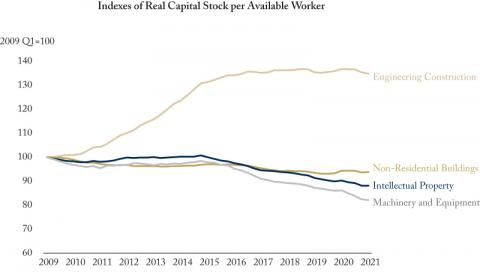From: William B.P. Robson and Miles Wu
To: Finance Minister Chrystia Freeland
Date: June 22, 2021
Re: The April Budget’s Upbeat Growth Forecast Won’t Happen without Stronger Business Investment
The backdrop to the long-term fiscal projections in your April budget – real economic growth averaging 2.1 percent annually – was remarkably optimistic. We certainly hope events bear it out – it is critical to the sustainability of post-pandemic fiscal policy, and prefigures healthy growth in incomes and living standards for current and future Canadians.
It was also a surprise. Pre-pandemic, the Department of Finance was projecting growth of 1.7 percent annually, and forecasters have generally become cautious since then. With demographic headwinds getting stronger, and no signs of accelerating productivity, the foundation for upgrading long-term growth – which, by its nature, has to rest on faster growth in Canada’s productive capacity – would have to be higher investment. Something for which we have no evidence – and something that should be high on your agenda to address.
Business investment is critical to economic growth. Not just as it occurs through jobs created by infrastructure construction, machinery installation and intellectual property spending, but over the long term – by equipping workers to make, and earn, more for every hour they work. A rising trend in the amount of capital each working Canadian has at her or his disposal would make an upbeat long-term forecast plausible.
But a rising trend in capital per working Canadian is exactly what we are not seeing. Statistics Canada tallies the stock of engineering structures, non-residential buildings, machinery and equipment (M&E), and intellectual property (IP) products. Removing inflation and comparing the resulting real stocks to Canada’s labour force gives us measures of capital per available worker – the tools the average Canadian has to produce, compete, and earn a living – shown in the figure (the figure uses a logarithmic scale to make trends in all the categories easier to see).
The story from the 2009 recovery to the middle of the last decade was not great, but at least the stock of capital rose, thanks mainly to additions to engineering spurred by our natural resource industries. After mid-decade, however, everything went the wrong way. Our stock of engineering per worker peaked, our stock of non-residential structures per worker sagged, and our stocks of M&E and IP products per worker – the categories of investment we typically associate with innovation and opportunity – declined.
The latest numbers are particularly disturbing because innovations spurred by the pandemic, combined with recovering economies, are boosting investment elsewhere. The OECD’s May Economic Outlook showed real gross investment in 2021 far outpacing growth in the workforce in the OECD area. In Canada, new investment is not even replacing old capital that is wearing out, and stocks per worker are falling. Especially in the areas – M&E and IP products – we most hope will lead the post-pandemic recovery.
We need to equip Canadian workers better with the capital that business investment creates – better infrastructure, non-residential buildings, M&E and IP products. If we do not, even the older, less buoyant, forecasts of long-term economic growth would be a stretch. And the newest one in your April budget would appear wildly optimistic. As former federal finance deputy minister and Governor of the Bank of Canada, David Dodge, commented, the budget was mainly about consumption, not investment. Its measures did not boost Canada’s prospects for long-term growth; they dampened them.
As we move from the 2021 budget to election platforms and new fiscal plans for 2022 and beyond, we need fiscal measures that will make buoyant forecasts for long-term growth more, rather than less, likely. We need a fiscal plan in which prudent management of expenses, rather than optimistic projections, ensure that our debt is sustainable. We need fewer promises of new programs, and a commitment to competitive tax rates. We need federal leadership in smart regulation, more competition, good infrastructure, and freer internal and international trade. In short, a mixture of carrots and sticks to give Canadian businesses incentives to invest, and the wherewithal to do it.
Transitioning from a consumption-fueled rebound to the sustainable longer-term growth envisioned in your April budget requires us to equip Canadian workers better. They need better tools to produce, compete, earn – and support the public programs the budget highlighted. As federal finance minister, you should be boosting business investment, to ensure they get those tools.
William Robson is CEO of the C.D. Howe Institute where Miles Wu is a Researcher.
To send a comment or leave feedback, email us at blog@cdhowe.org.
The views expressed here are those of the authors. The C.D. Howe Institute does not take corporate positions on policy matters.






